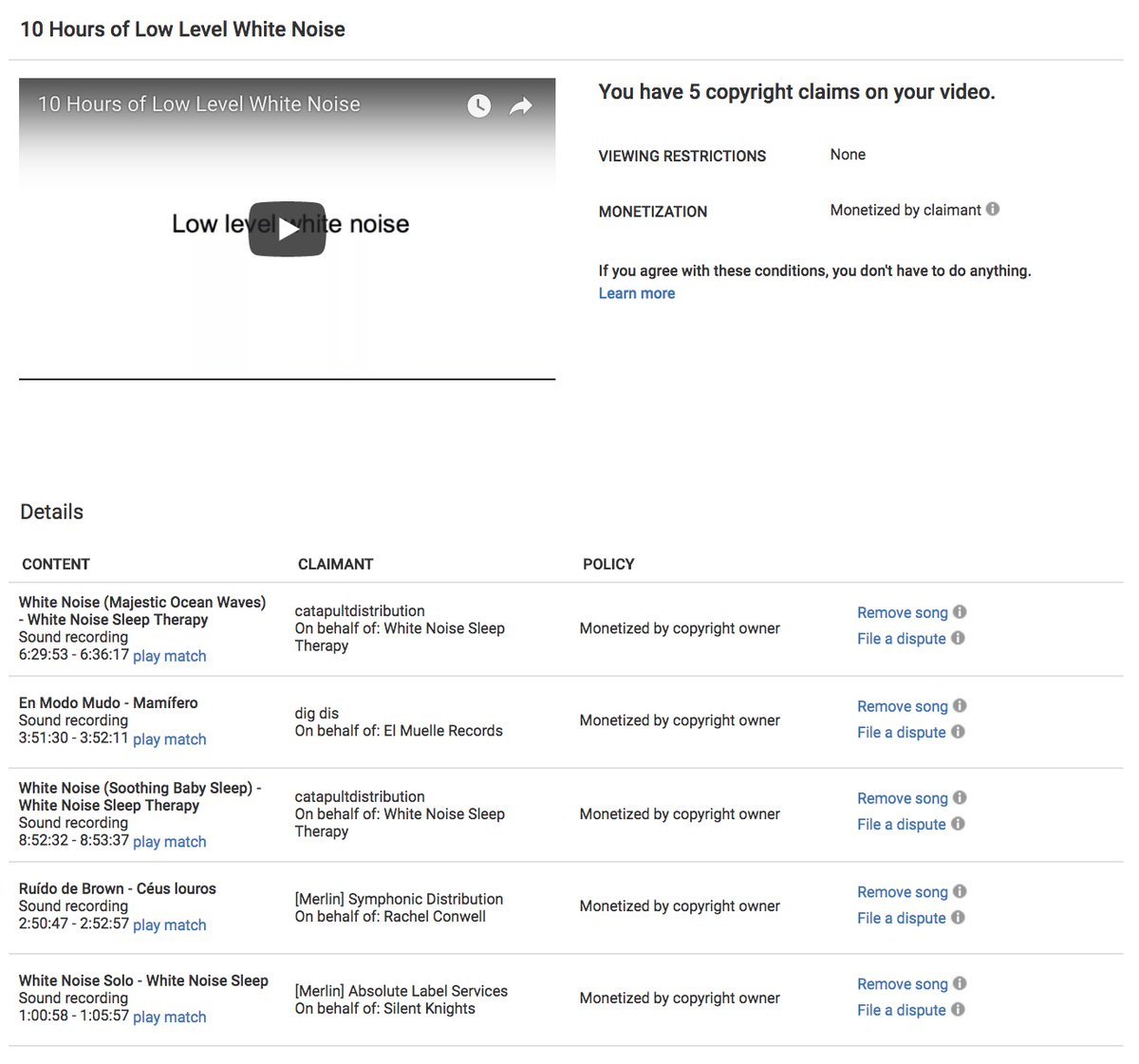White noise recording on YouTube received five claims from five different rights holders
 YouTube fully supports rights holders and makes sure that their works are not laid out in one form or another illegally. In most cases, the “restoration of justice” procedure takes place quite regularly - a video clip that violates someone’s rights, is simply deleted, or it is provided to copyright holders with the opportunity to profit from such videos.
YouTube fully supports rights holders and makes sure that their works are not laid out in one form or another illegally. In most cases, the “restoration of justice” procedure takes place quite regularly - a video clip that violates someone’s rights, is simply deleted, or it is provided to copyright holders with the opportunity to profit from such videos.
There are also funny cases. For example, in one of the cases of YouTube, the audio track was removed from the video of the many hours of scientific conference. And all because during a break in the hall of the building where this conference was held, music protected by copyright sounded. An even more unusual case occurred in 2012 - then the ornithologist who posted the recording of birds songs on YouTube received several complaints from companies that declared that chirping (well, or quacking and kurklyanie) are copyrighted sound series. Wind noise, too, it turns out, is protected by law and belongs to someone. But that's not all - the other day it became known about the out of the ordinary case.
The musician, fond of sound theory, created a ten-hour recording of white noise. This post he posted on YouTube. But what was his surprise when he began to receive claims from the "right holders", who stated that the recordings contain songs whose rights belong to them. For the year Sevastian Tomczak (Sebastian Tomczak) received five such claims.
“I study and work in the Faculty of Music at the University of Australia. My field of interest is the intersection of music theory and the physics of sounds. I am engaged in programming, modular synthesizing, digitizing sounds, creating music and sounds for games, etc., ”says Tomchak.
About ten years ago, he started a blog about music and everything connected with it. He described the research and their results. One day a researcher created an audio file with a ten-hour recording of white noise and uploaded it to YouTube.
He had previously laid out similar videos, but white noise was only a part, a component of the work. This time he decided to take all the ten hours under the white noise. What for? To check how the sound acts on the human mind and its performance.
White noise is created by combining sounds of different frequencies into a single unit. So it turns out a kind of vinaigrette sounds. Some people claim that white noise helps them fall asleep better, or distract themselves from annoying factors, such as street sounds, air conditioning noise, etc.
The file was obtained by scientists using Audacity free audio editor and a built-in noise generator. Then the file was imported into ScreenFlow, here the author added the text and converted everything into a 10-hour video. The video itself was uploaded to YouTube in July 2015.
A few days ago, he accidentally noticed that the video had received a claim from the right holder - a certain company that he had never heard of. After checking his account for other claims, he found them. In total, five such claims were received during the year. The screenshot from the account is below.

One of the companies, Catapult Distribution, said that Tomchak's video violates its rights with respect to the composition of the “White Noise Sleep Therapy” commercial audio file set. The composition in question is sold and called “Majestic Ocean Waves”. In addition, Catapult Distribution also declared a violation of its rights in relation to another video - “Soothing Baby Sleep”. Other companies, Merlin Symphonic Distribution and Dig Dis, have also filed claims for similar reasons.
In a typical situation, the scientist’s account would be frozen for numerous copyright infringements. But the right holders did not seek lock. Instead, they stated that they would like to get their own by transferring the income from viewing the video to their account. This is done automatically using the ContentID system from YouTube.
Now the scientist is going to open a dispute on YouTube in order to prove that his work is unique, and there are no analogues (in terms of coincidence of the scale and other elements). “I can challenge the copyright holders' complaint, saying that I have all the source code of the work, which allows us to prove its originality. It has always worked, and I hope that this method will not fail now, ”says Tomchak. The author of the composition with white noise says that the system of automatic submission and review from YouTube requires serious improvement.
All Articles